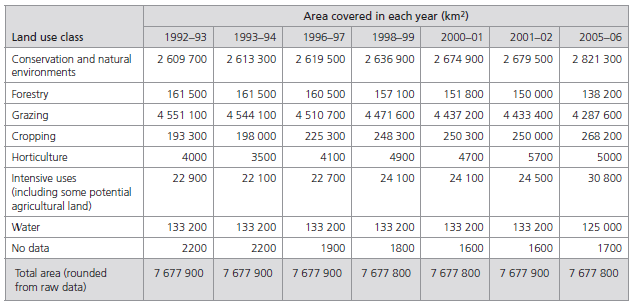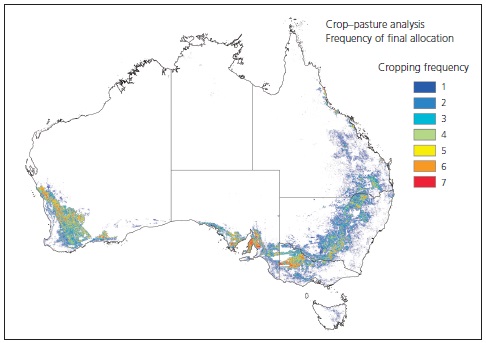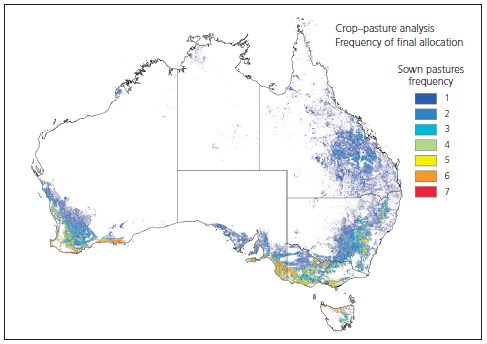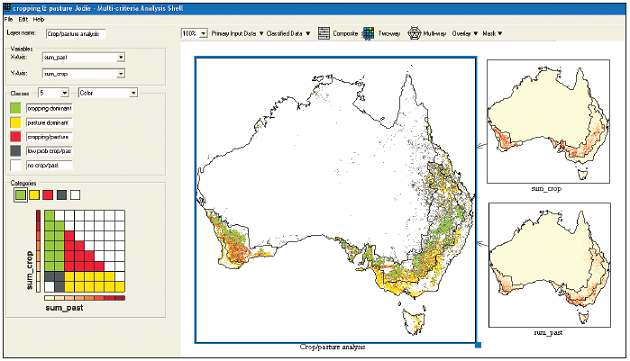Changes in land use based on the national scale land use datasets
Table 1 shows the change in area of seven broad land use classes at the national level from 1992-93 to 2005-06. Conservation land uses (including Indigenous lands and minimal use areas such a residual native cover and Defence land in natural areas) have increased by almost 212 000 sqkm (almost 8% of Australia) between 1992-93 and 2005-06 to almost 2 821 000 sqkm.
The area of land classed as grazing has been slowly decreasing since 1992-93 from a high of just over 4 550 000 sqkm to less than 4 288 000 sqkm in 2005-06 (a decrease of over 6%).
The area of cropping has increased by almost 75 000 sqkm (over 38%) over the same time period to 268 000 sqkm.
The area of horticulture increased around 1000 sqkm between 1992-93 and 2005-06; this was not gradual but spiked in 1998-99 and 2001-02. However, it should be noted that these years were agricultural survey rather than census years and so the lower number of respondents could result in larger sampling errors.
Intensive uses appear to have a marked increase between 2001-02 and 2005-06. While an increase in area is probable, the magnitude may be exaggerated due to the mapping of finer scale intensive land use classes in 2005-06 which were not mapped in previous years. These classes include intensive plant and animal production, services, utilities, transportation and waste. The inclusion of these classes saw the area of intensive uses rise to almost 31 000 sqkm in 2005-06.
Forestry has shown a decrease of over 23,000 sqkm (over 14%), however, it should be noted that many areas designated as forest in other datasets are classed as conservation in the land use datasets as this is their primary use. Therefore, these other datasets should be sourced if specifically interested in forest areas.
The same water dataset was used for the 1992-93 to 2001-02 land use datasets and so the table shows no change in the area of water features. The updated water dataset used in the 2005-06 map showed a decrease in the area of marshes/wetlands and estuary/coastal waters.
Table 1. Changes in land use from 1992-93 to 2005-06 based on series of national land use datasets
Detecting crop-pasture rotations
The time-series of national land use maps have been analysed to identify areas of permanent cropping, permanent pastures and areas in a crop/pasture rotation. For each year cropping areas (dryland and irrigated) were identified and then summed across the time-series to show how frequently an area was assigned to a cropping class (see Figure 1). The same process was carried out for pasture areas (see Figure 2).
These layers were then combined using the Multi-Criteria Analysis Shell (MCAS-S) tool which is a decision support tool produced by ABARES used to conduct spatial information assessments and convey complex information in a readily understood manner (it can be downloaded from www.abares.gov.au/mcass). The layers were combined to determine areas that were predominantly cropped, areas that were predominantly pasture and areas where neither dominated. These areas are presumed to be in rotation. In Figure 3, areas in green are those that are predominantly pasture (rarely if ever cropped), areas in yellow are predominantly cropped (rarely if ever pasture) and those in red are likely to be in a crop/pasture rotation. Areas in grey are allocated as very low probability crop or pasture, and areas in white were never allocated to crop or pasture.




